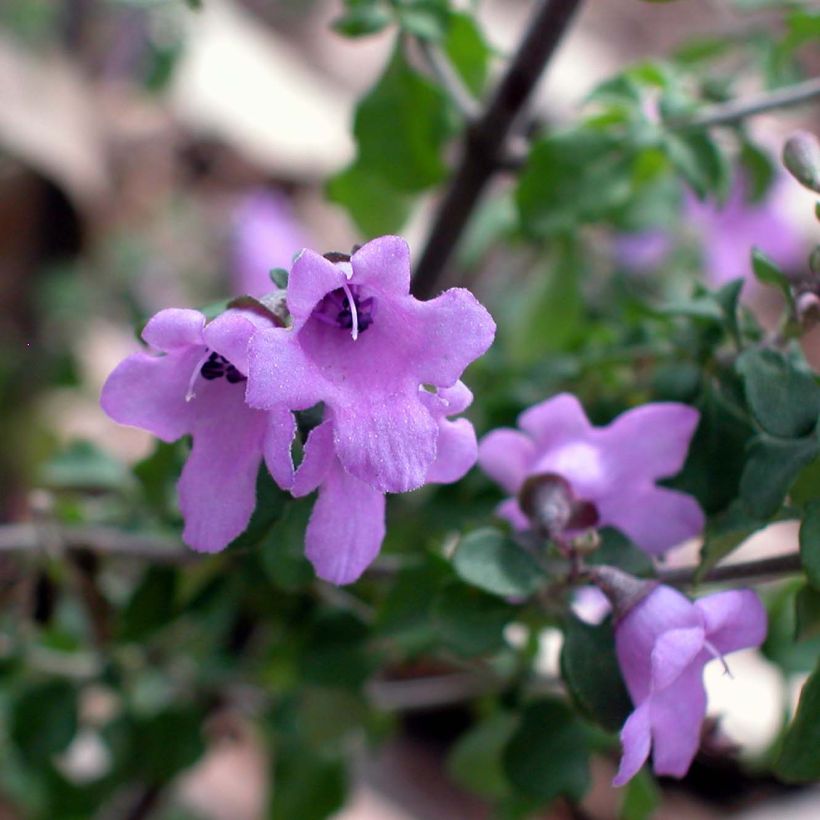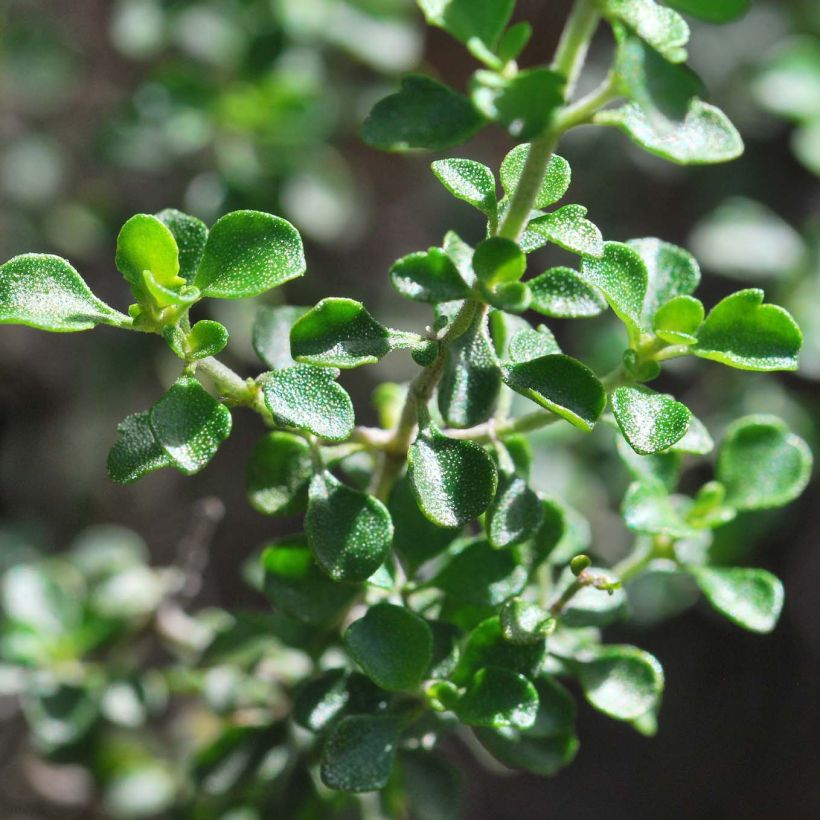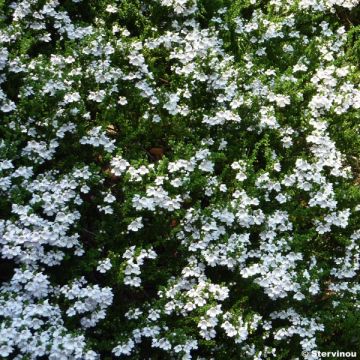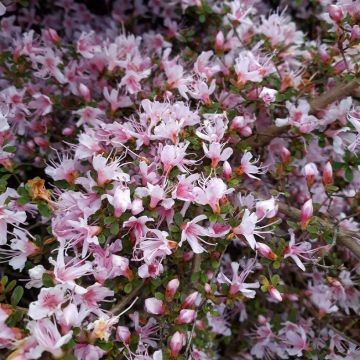

Prostanthera rotundifolia - Menthe d'Australie, Menthe en arbre.


Prostanthera rotundifolia - Menthe d'Australie, Menthe en arbre.
Prostanthera rotundifolia - Mint Bush
Prostanthera rotundifolia
Round-leaf Mint Bush
BEAUTIFUL YOUNG PLANT WITH A FRAGRANT FLOWER, THE FOLIAGE CHANGES FROM GREEN TO BROWN BUT THE PLANT WILL SOON FLOWER. TEZAM
Michel, 31/03/2023
This item cannot be shipped to the selected country
Delivery charge from €5.90
More information
Schedule delivery date,
and select date in basket
This plant carries a 24 months recovery warranty
More information
We guarantee the quality of our plants for a full growing cycle, and will replace at our expense any plant that fails to recover under normal climatic and planting conditions.
From €5.90 for pickup delivery and €6.90 for home delivery
Express home delivery from €8.90.

Does this plant fit my garden?
Set up your Plantfit profile →
Description
Prostanthera rotundifolia, sometimes called Australian Mint due to its origins or Tree Mint, is a frost-tolerant shrub, which is well adapted to dry and poor soils. It forms a rounded but light weight bush with small leaves that become greyer when the soil is dry. It is covered in spring with a multitude of small tubular flowers, gathered in violet clusters. Endowed with a somewhat indefinable charm, it deserves to be seen and smelled up close and will undoubtedly impress the curious visitor, touched by its sometimes fragile appearance despite its undemanding resilience. To succeed in mild climates, remember that it does not like water in summer, but appreciates partial shade, especially in hot climates. Do not place it on the lawn and avoid regular watering which could cause it to perish as much as a severe frost!
Prostanthera rotundifolia, meaning round-leaved, is native to eastern Australia, New South Wales, the state of Victoria, and Tasmania. It is a plant that thrives in well-drained and dry soil, and also does well in oceanic climates, as seen by beautiful specimens planted in sheltered positions in certain coastal gardens. This highly branched shrub has a rounded, slightly spreading habit, supported by slender, hairy, square-sectioned branches. Its growth is quite fast in moist soil, a little slower in dry and poor soil. The lifespan of this plant is about 6 to 8 years, including in its native lands. An adult specimen will reach an average height of 2m (7ft) with a spread of 1.5m (5ft). Its evergreen foliage is composed of small, simple, opposite, rounded to ovate, dentate leaves, measuring 1cm (1in) to 1.5cm (1in) in length. They are dark green in colour, but covered in white hairs that give them a more greyish hue, especially in hot and dry climates. When crushed, they emit a pleasant menthol scent. Flowering takes place in April-May. The small bell-shaped flowers with 5 lobes are grouped in clusters measuring 5 to 7cm (2 to 3in) in length. They emerge from the axils of reduced leaves, on lateral branches. The flower size varies between 0.5 and 1cm (1in) in length and their colours vary between light violet and purple. The fruit is like a small almond.
Australian Mint is elegant, subtle for much of the year, and delightful in spring. The shrub is tolerant in terms of soil type, resistant to drought, and not afraid of salt spray. Its only enemy is the cold, which can make it disappear when temperatutres fall below -5°C (23°F) if the soil is not sufficiently well-drained. It requires little maintenance and even prefers to be forgotten from time to time, especially in summer. A light annual pruning after flowering is sufficient. It will easily thrive in gardens along the Atlantic or Mediterranean coast. It forms beautiful borders, along a wall or in a well-drained bed, in the company of evergreen Melaleuca, Gomphostigma, Leptospermum, and lower growing Ceanothus (Italian Skies, Concha, Victoria). Mimosa, Leucophyllum, Raphiolepis, Oleander, Callistemon, or Grevillea can also accompany it in a dry or coastal garden. The choice is vast, it's all a matter of taste. Container cultivation can allow the shrub to overwinter in a cold greenhouse or a very bright and minimally heated conservatory in very cold regions.
Report an error about the product description
Prostanthera rotundifolia - Mint Bush in pictures




Plant habit
Flowering
Foliage
Botanical data
Prostanthera
rotundifolia
Lamiaceae
Round-leaf Mint Bush
Australia
Other Prostanthera
Planting and care
Prostanthera rotundifolia is preferably planted in spring, after the last frosts, or in autumn in very mild climates, in a sunny position, or even semi-shaded position at the hottest hours of the day in hot climates. It is not very demanding about the type of soil, as long as it is perfectly drained. It adapts to any sandy, rocky, gravelly, poor, acid to clay-limestone soil, but in the latter case, it should be lightened with gravel and leaf compost. Growing it in a pot allows better control of the substrate and protects the plant from frost in areas with borderline hardiness ,down to -5/-6°C (23/21.2°F) for a well-established plant. Caution: as the plant dislikes the combination of heat and humidity, watering in pots should be spaced out, allowing the soil to dry between waterings.
Prostanthera plants are generally drought-resistant once well-established: monitor watering during the first 2 summers, after when it becomes optional and even unnecessary. Like Westringia, lavender, and rosemary, these bushes sometimes prefer to be forgotten rather than pampered. Summer watering, apart from natural rainfall, should be avoided. In open ground, they appreciate a thick layer of mulch and a fertilizer application for flowering shrubs if the soil is very poor.
The Australian Mint should be pruned lightly after flowering to maintain a dense habit, providing the gardener with an opportunity to breathe in a minty scent!
Propagation:
By taking semi-woody cuttings just after flowering. The cuttings should be protected from frost.
Planting period
Intended location
Care
-
, onOrder confirmed
Reply from on Promesse de fleurs
Evergreen shrubs
Haven't found what you were looking for?
Hardiness is the lowest winter temperature a plant can endure without suffering serious damage or even dying. However, hardiness is affected by location (a sheltered area, such as a patio), protection (winter cover) and soil type (hardiness is improved by well-drained soil).

Photo Sharing Terms & Conditions
In order to encourage gardeners to interact and share their experiences, Promesse de fleurs offers various media enabling content to be uploaded onto its Site - in particular via the ‘Photo sharing’ module.
The User agrees to refrain from:
- Posting any content that is illegal, prejudicial, insulting, racist, inciteful to hatred, revisionist, contrary to public decency, that infringes on privacy or on the privacy rights of third parties, in particular the publicity rights of persons and goods, intellectual property rights, or the right to privacy.
- Submitting content on behalf of a third party;
- Impersonate the identity of a third party and/or publish any personal information about a third party;
In general, the User undertakes to refrain from any unethical behaviour.
All Content (in particular text, comments, files, images, photos, videos, creative works, etc.), which may be subject to property or intellectual property rights, image or other private rights, shall remain the property of the User, subject to the limited rights granted by the terms of the licence granted by Promesse de fleurs as stated below. Users are at liberty to publish or not to publish such Content on the Site, notably via the ‘Photo Sharing’ facility, and accept that this Content shall be made public and freely accessible, notably on the Internet.
Users further acknowledge, undertake to have ,and guarantee that they hold all necessary rights and permissions to publish such material on the Site, in particular with regard to the legislation in force pertaining to any privacy, property, intellectual property, image, or contractual rights, or rights of any other nature. By publishing such Content on the Site, Users acknowledge accepting full liability as publishers of the Content within the meaning of the law, and grant Promesse de fleurs, free of charge, an inclusive, worldwide licence for the said Content for the entire duration of its publication, including all reproduction, representation, up/downloading, displaying, performing, transmission, and storage rights.
Users also grant permission for their name to be linked to the Content and accept that this link may not always be made available.
By engaging in posting material, Users consent to their Content becoming automatically accessible on the Internet, in particular on other sites and/or blogs and/or web pages of the Promesse de fleurs site, including in particular social pages and the Promesse de fleurs catalogue.
Users may secure the removal of entrusted content free of charge by issuing a simple request via our contact form.
The flowering period indicated on our website applies to countries and regions located in USDA zone 8 (France, the United Kingdom, Ireland, the Netherlands, etc.)
It will vary according to where you live:
- In zones 9 to 10 (Italy, Spain, Greece, etc.), flowering will occur about 2 to 4 weeks earlier.
- In zones 6 to 7 (Germany, Poland, Slovenia, and lower mountainous regions), flowering will be delayed by 2 to 3 weeks.
- In zone 5 (Central Europe, Scandinavia), blooming will be delayed by 3 to 5 weeks.
In temperate climates, pruning of spring-flowering shrubs (forsythia, spireas, etc.) should be done just after flowering.
Pruning of summer-flowering shrubs (Indian Lilac, Perovskia, etc.) can be done in winter or spring.
In cold regions as well as with frost-sensitive plants, avoid pruning too early when severe frosts may still occur.
The planting period indicated on our website applies to countries and regions located in USDA zone 8 (France, United Kingdom, Ireland, Netherlands).
It will vary according to where you live:
- In Mediterranean zones (Marseille, Madrid, Milan, etc.), autumn and winter are the best planting periods.
- In continental zones (Strasbourg, Munich, Vienna, etc.), delay planting by 2 to 3 weeks in spring and bring it forward by 2 to 4 weeks in autumn.
- In mountainous regions (the Alps, Pyrenees, Carpathians, etc.), it is best to plant in late spring (May-June) or late summer (August-September).
The harvesting period indicated on our website applies to countries and regions in USDA zone 8 (France, England, Ireland, the Netherlands).
In colder areas (Scandinavia, Poland, Austria...) fruit and vegetable harvests are likely to be delayed by 3-4 weeks.
In warmer areas (Italy, Spain, Greece, etc.), harvesting will probably take place earlier, depending on weather conditions.
The sowing periods indicated on our website apply to countries and regions within USDA Zone 8 (France, UK, Ireland, Netherlands).
In colder areas (Scandinavia, Poland, Austria...), delay any outdoor sowing by 3-4 weeks, or sow under glass.
In warmer climes (Italy, Spain, Greece, etc.), bring outdoor sowing forward by a few weeks.















































